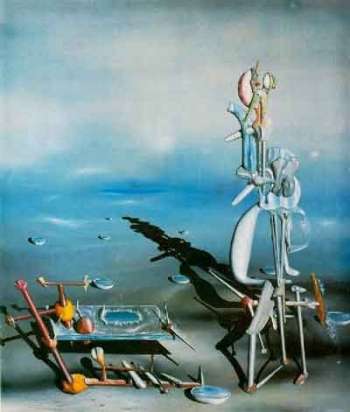Surrealism

It was the end of sorrow lies. The rail stations were dead, flowing like bees stung from honeysuckle. The people hung back and watched the ocean, animals flew in and out of focus. The time had come. Yet king dogs never grow old - they stay young and fit, and someday they might come to the beach and have a few drinks, a few laughs, and get on with it. But not now. The time had come; we all knew it. But who would go first?—Les Champs Magnetique, Andre Breton
Reality is broken. Everything seems bizarre, possibly nightmarish, and certainly dream-like.
Surrealism was a movement encompassing both literature and art, originating in Europe between the World Wars. The aim was to make art that reflected the fundamental truth about the world; they took the name surrealism (the prefix sur- means "super") because they considered themselves super-realists. They were also huge fans of Sigmund Freud, whose psychoanalysis was the hottest fad of the decade, so the surrealists' super-realism was essentially art about the subconscious, as Freud envisioned it.
One major branch used very abstracted art to symbolically represent the subconscious. The other, better-known, branch attempted to more-or-less literally depict the strange logic of one's dreams—this was the surrealism of Salvidor Dalí's melting clocks and René Magritte's flying men in bowler hats.
Due to the popularity of the latter branch, the definition of "surrealism" drifted. People remembered the melty clocks, but forgot they came from the subconscious, so for those outside the movement, "surreal" became a synonym for "bizarre and nightmarish".
If the world looks mundane but Fridge Logic makes you wonder why people aren't making more of a fuss about some of the stuff going on then it's probably Magic Realism—which is actually a later offshoot of Dalí-style surrealism.
Compare Uncanny Valley and Eldritch Abomination. See also Surreal Horror and Surreal Humor. Also compare the (anti)-art movement that preceded and inspired it.
- Alchemy
- All Psychology Is Freudian
- Animal Motifs: Several artists had them.
- Banned in China: Or Nazi Germany.
- Based on a Dream
- Breakout Character: Salvador Dali.
- Casanova: Max Ernst (also perhaps a real-life White-Haired Pretty Boy).
- Dirty Communists: Many of the surrealists were radical leftists.
- Freud Was Right
- Getting Crap Past the Radar: An art form in itself in occupied countries.
- La Résistance: Several artists who remained in occupied France were part of it (Paul Eluard, Louis Aragon).
- Love Dodecahedron: A real-life example.
- Manic Pixie Dream Girl: The quest for a muse was basically the search for a Manic Pixie Dream Girl who could get the guy in touch with his spiritual side.
- Mind Screw
- Mistaken for Spies: Max Ernst. Because what else would a German be doing in France?
- Older Than They Think: Some works of medieval painter Hieronymus Bosch are very surrealistic.
- Real Dreams Are Weirder
- Spooky Seance: They loved them.
- True Art Is Angsty: Magritte, mostly, though he could be extremely funny as well.
- True Art Is Incomprehensible: Seems that way to a lot of people.
- Unreliable Narrator
- World War II: Interrupted the movement.